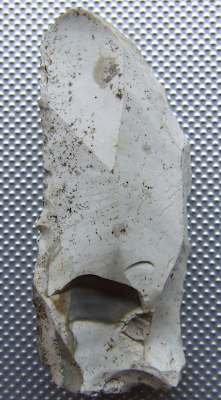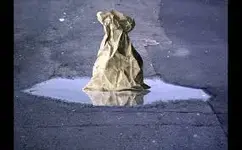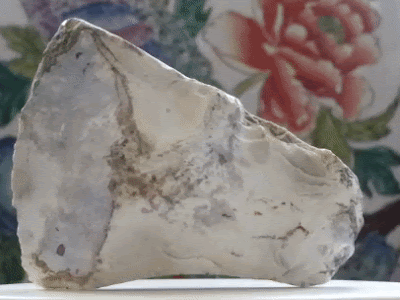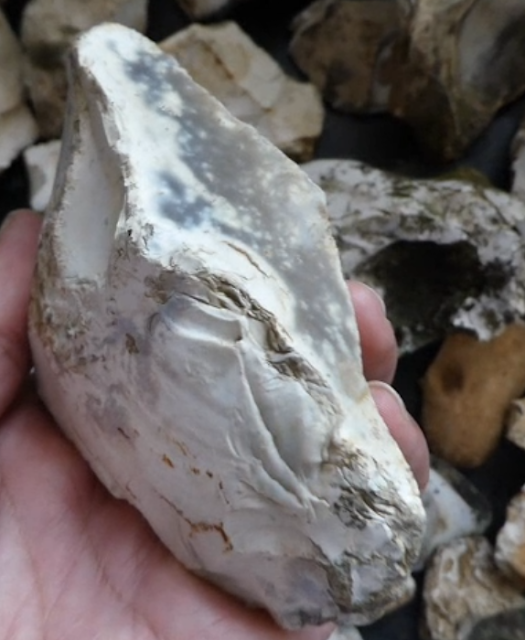You are using an out of date browser. It may not display this or other websites correctly.
You should upgrade or use an alternative browser.
You should upgrade or use an alternative browser.
Rock
- Thread starter Eolith
- Start date
No.
The likelyhood of it being an axe head might increase if it weighs over 50 pounds.
From your nondescript ,no size reference picture and lack of context , it's a piece of material about as big as a 25 cent piece.
As an edged piece of material to use as a tool , it has a horrendous uneven edge.
If you prefer a Z shaped edge on your cutting tools. You're in luck!
From your nondescript ,no size reference picture and lack of context , it's a piece of material about as big as a 25 cent piece.
As an edged piece of material to use as a tool , it has a horrendous uneven edge.
If you prefer a Z shaped edge on your cutting tools. You're in luck!
Arkansaw
Full Member
- Joined
- Nov 23, 2018
- Messages
- 205
- Reaction score
- 237
- Golden Thread
- 0
- Location
- SW Missouri
- Primary Interest:
- Relic Hunting
That edge looks like it was used to crush
Eolith
Greenie
- Joined
- Mar 11, 2020
- Messages
- 12
- Reaction score
- 0
- Golden Thread
- 0
- Primary Interest:
- All Treasure Hunting
- #6
Thread Owner
it has retouch on the cutting blade, controversial i know but can you see the rough shape and colour match to an Orca on the gray/white top surface shown in the second picture?
- Joined
- Dec 23, 2019
- Messages
- 6,322
- Reaction score
- 20,200
- Golden Thread
- 0
- Location
- Surrey, UK
- Primary Interest:
- All Treasure Hunting
it has retouch on the cutting blade, controversial i know but can you see the rough shape and colour match to an Orca on the gray/white top surface shown in the second picture?
I don't see it... but please explain this. The colourations you're seeing there on the broken surface are the result of patination which takes at minimum hundreds of years and usually thousands of years to develop. Fresh flint is not white. It develops that colour as a result of hydration and chemical alteration which begins on the exterior and gradually progresses through to the interior. How could anyone know that the interior colouration pattern would resemble an orca before a flint nodule was broken open... or predict that it would ultimately develop in that way after it had been broken open?
I await your explanation with interest.
tamrock
Platinum Member
- Joined
- Dec 23, 2019
- Messages
- 6,322
- Reaction score
- 20,200
- Golden Thread
- 0
- Location
- Surrey, UK
- Primary Interest:
- All Treasure Hunting
Ah... so it's a Hadrosaurus, not an orca. Sorry. My mistake. They're easily confused. Just a thought though... might it actually be the little-known Orcasaurus.
The 'fossil tooth' appears to be the lithified infill from a shrimp burrow. They're common in Britain in flint-bearing marine sedimentary deposits.
The video is hilarious.
Eolith
Greenie
- Joined
- Mar 11, 2020
- Messages
- 12
- Reaction score
- 0
- Golden Thread
- 0
- Primary Interest:
- All Treasure Hunting
- #10
Thread Owner
I don't see it... but please explain this. The colourations you're seeing there on the broken surface are the result of patination which takes at minimum hundreds of years and usually thousands of years to develop. Fresh flint is not white. It develops that colour as a result of hydration and chemical alteration which begins on the exterior and gradually progresses through to the interior. How could anyone know that the interior colouration pattern would resemble an orca before a flint nodule was broken open... or predict that it would ultimately develop in that way after it had been broken open?
I await your explanation with interest.
That is a good question and I am only beginning to get anywhere close to answering it, scientific testing needs to be carried out, first off I am not going to assume that everything you say is 100% correct, however it does mostly appear to match observation with regards to patination in flint, but flint also has inclusions. There are a few possibilities, but one theory is that applied materials block hydration/oxidization of the flint in certain areas causing the differing patterns. I have supporting evidence of this theory on my blog.
Its actually really easy to so a whale likeness on the top platform, the dorsal and pectoral fins a weak but still present, the tail is there, the white areas do match quite closely with the white areas of an orca.
Eolith
Greenie
- Joined
- Mar 11, 2020
- Messages
- 12
- Reaction score
- 0
- Golden Thread
- 0
- Primary Interest:
- All Treasure Hunting
- #11
Thread Owner
Ah... so it's a Hadrosaurus, not an orca. Sorry. My mistake. They're easily confused. Just a thought though... might it actually be the little-known Orcasaurus.
The 'fossil tooth' appears to be the lithified infill from a shrimp burrow. They're common in Britain in flint-bearing marine sedimentary deposits.
The video is hilarious.
Yeah look carefully its a bird too.
Eolith
Greenie
- Joined
- Mar 11, 2020
- Messages
- 12
- Reaction score
- 0
- Golden Thread
- 0
- Primary Interest:
- All Treasure Hunting
- #12
Thread Owner

This flint blade also from my find site has a differing patina on the lower edge, that platform was likely used for harfting, and the glue blocked oxidization in that area for an unknown length of time, glue has since gone, differance in patina remains.
- Joined
- Dec 23, 2019
- Messages
- 6,322
- Reaction score
- 20,200
- Golden Thread
- 0
- Location
- Surrey, UK
- Primary Interest:
- All Treasure Hunting
This flint blade also from my find site has a differing patina on the lower edge, that platform was likely used for harfting, and the glue blocked oxidization in that area for an unknown length of time, glue has since gone, differance in patina remains.
Sorry, but that doesn't withstand scientific scrutiny.
The patination of flint is not an oxidative process and covering part of it in glue (primitive glue at that) will not stop it.
Patination is caused by the action of water and water-soluble chemicals on the unstable impurities within the flint. Typically, flint in a wet environment will absorb around 2% of its weight as moisture, starting with surface absorption (unless the flint is cracked). Then, at a micro-structural level, the flint becomes more porous as a result of tiny voids being created by dissolution and leaching of carbonates, loosening of quartz crystallites and dispersal of clay particulates. The effect of patination then penetrates further and further into the flint. That will still happen, even underneath a layer of glue, except in completely dry environments.
The rate at which this happens is governed only by the structure and composition of the flint, the amount of water it is exposed to and the chemicals contained in that water (plus a small temperature effect). The major factors are the pH of the water plus the sodium/potassium ratio if it’s alkaline, or the presence of decomposition products from plant matter if it’s acid.
Flint usually has either a chalky white patina or a ferruginous brown patina. White patination is usually primarily the result of iron oxides and hydrated iron oxides being leached out by oxalic acid derived from plant decomposition. In addition to creating ‘whiteness’ by removal of iron pigments which would otherwise cause it to be dark, there is also an optical effect resulting from changes to the reflective and refractive properties.
The item you’re showing has a darker and more reflective patch because it has suffered a chip to that area which is very much more recent than the other fractures and an as-yet unpatinated portion has been exposed. No-one could have known what the underlying colour or pattern would be until after that chip had happened, and the same is true for your supposed ‘orca’ colouration.
Eolith
Greenie
- Joined
- Mar 11, 2020
- Messages
- 12
- Reaction score
- 0
- Golden Thread
- 0
- Primary Interest:
- All Treasure Hunting
- #14
Thread Owner
The item you’re showing has a darker and more reflective patch because it has suffered a chip to that area which is very much more recent than the other fractures and an as-yet unpatinated portion has been exposed. No-one could have known what the underlying colour or pattern would be until after that chip had happened, and the same is true for your supposed ‘orca’ colouration.
There is no evidence of a chip, its one flat plain with two colours. Hmm not oxidization huh? wait a minute water is one part oxogen......
My pigments that I had tested with FTIR spectroscopy contain celulose, which is water proof....
- Joined
- Dec 23, 2019
- Messages
- 6,322
- Reaction score
- 20,200
- Golden Thread
- 0
- Location
- Surrey, UK
- Primary Interest:
- All Treasure Hunting
There is no evidence of a chip, its one flat plain with two colours. Hmm not oxidization huh? wait a minute water is one part oxogen......
My pigments that I had tested with FTIR spectroscopy contain celulose, which is water proof....
Boy... do you need to brush up on your chemistry (and your logic)
- Joined
- Dec 23, 2019
- Messages
- 6,322
- Reaction score
- 20,200
- Golden Thread
- 0
- Location
- Surrey, UK
- Primary Interest:
- All Treasure Hunting
Here’s a paper bag composed principally of cellulose fibres demonstrating how remarkably “waterproof” it is. And what do you think absorbent kitchen towels are made from?

The fact that oxygen is one of the component elements of water has nothing whatsoever to do with whether it can act as an oxidising agent. What determines an oxidising agent is whether it can accept one or more electrons from other substances and the degree to which that is possible is determined by the difference in redox potential between it and other substances it comes into contact with and/or is influenced by.
Under normal circumstances water is neither a strong oxidising agent nor a strong reducing agent. Water has typical redox potential of only about +200mv (groundwater usually a little higher at +250mv) and these values are nowhere near high enough for water to oxidise any of the components of flint. Its only role in patination is that (because it’s pretty much a universal solvent) it enables other dissolved substances to chemically react with and/or solubilise some of the impurities in flint.

The fact that oxygen is one of the component elements of water has nothing whatsoever to do with whether it can act as an oxidising agent. What determines an oxidising agent is whether it can accept one or more electrons from other substances and the degree to which that is possible is determined by the difference in redox potential between it and other substances it comes into contact with and/or is influenced by.
Under normal circumstances water is neither a strong oxidising agent nor a strong reducing agent. Water has typical redox potential of only about +200mv (groundwater usually a little higher at +250mv) and these values are nowhere near high enough for water to oxidise any of the components of flint. Its only role in patination is that (because it’s pretty much a universal solvent) it enables other dissolved substances to chemically react with and/or solubilise some of the impurities in flint.
Eolith
Greenie
- Joined
- Mar 11, 2020
- Messages
- 12
- Reaction score
- 0
- Golden Thread
- 0
- Primary Interest:
- All Treasure Hunting
- #17
Thread Owner
The irony, you cant see the shape of a whale that is there, but you can see a chip that isnt. You need to brush up on a few things too, here is a paper covering oxidation on flint surfaces.
https://www.researchgate.net/public..._Loess_Terrain_of_the_Netherlands_and_Belgium
https://www.researchgate.net/public..._Loess_Terrain_of_the_Netherlands_and_Belgium
- Joined
- Dec 23, 2019
- Messages
- 6,322
- Reaction score
- 20,200
- Golden Thread
- 0
- Location
- Surrey, UK
- Primary Interest:
- All Treasure Hunting
The irony, you cant see the shape of a whale that is there, but you can see a chip that isnt. You need to brush up on a few things too, here is a paper covering oxidation on flint surfaces.
https://www.researchgate.net/public..._Loess_Terrain_of_the_Netherlands_and_Belgium
Have you even read that paper? It doesn't "cover oxidation on flint surfaces" at all. It says pretty much what I have already said but additionally mentions the effect of UV (from sunlight) on patination. I deliberately ignored that in my reply because it's very much a localised surface effect which does not penetrate as deeply as shown on your piece. There is nothing... absolutely nothing... in that paper which supports any of the mistaken assertions you make about glue protecting flint from patination, the role of water as an oxidant for flint components or the absurd 'explanations' you give for the resemblances to orca colourations.
- Joined
- Dec 23, 2019
- Messages
- 6,322
- Reaction score
- 20,200
- Golden Thread
- 0
- Location
- Surrey, UK
- Primary Interest:
- All Treasure Hunting
Oh I notice a lot of backtracking from you, case closed, go troll somewhere else.
Pot... may I introduce you to kettle?
Similar threads
- Replies
- 11
- Views
- 421
Users who are viewing this thread
Total: 1 (members: 0, guests: 1)





